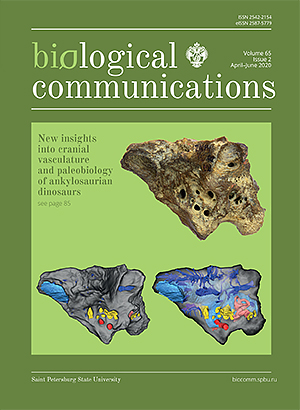The braincase of Bissektipelta archibaldi — new insights into endocranial osteology, vasculature, and paleoneurobiology of ankylosaurian dinosaurs
DOI:
https://doi.org/10.21638/spbu03.2020.201Abstract
We describe in detail three braincases of the ankylosaur Bissektipelta archibaldi from the Late Cretaceous (Turonian) of Uzbekistan with the aid of computed tomography, segmentation, and 3D modeling. Bissektipelta archibaldi is confirmed as a valid taxon and attributed to Ankylosaurinae based on the results of a phylogenetic analysis. The topographic relationships between the elements forming the braincase are determined using a newly referred specimen with preserved sutures, which is an exceedingly rare condition for ankylosaurs. The mesethmoid appears to be a separate ossification in the newly referred specimen ZIN PH 281/16. We revise and discuss features of the neurocranial osteology in Ankylosauria and propose new diagnostic characters for a number of its subclades. We present a 3D model of the braincase vasculature of Bissektipelta and comment on vascular patterns of armored dinosaurs. A complex vascular network piercing the skull roof and the wall of the braincase is reported for ankylosaurs for the first time. We imply the presence of a lepidosaur-like dorsal head vein and the venous parietal sinus in the adductor cavity of Bissektipelta. We suggest that the presence of the dorsal head vein in dinosaurs is a plesiomorphic diapsid trait, and extant archosaur groups independently lost the vessel. A study of two complete endocranial casts of Bissektipelta allowed us to compare endocranial anatomy within Ankylosauria and infer an extremely developed sense of smell, a keen sense of hearing at lower frequencies (100–3000 Hz), and the presence of physiological mechanisms for precise temperature control of neurosensory tissues at least in derived ankylosaurids.
Keywords:
Dinosauria, Ankylosauria, endocast, blood vessels, paleobiology, Late Cretaceous, Uzbekistan
Downloads
References
Downloads
Published
How to Cite
License
Articles of Biological Communications are open access distributed under the terms of the License Agreement with Saint Petersburg State University, which permits to the authors unrestricted distribution and self-archiving free of charge.





